ScaMaha: A Tool for Parsing, Analyzing, and Visualizing Object-Oriented Software Systems
- 1. ScaMaha: A Tool for Parsing, Analyzing, and Visualizing Object-Oriented Software Systems Dr. Ra'Fat Al-Msie'deen Department of Software Engineering, Faculty of IT, Mutah University, Mutah 61710, Karak, Jordan [email protected] https://rafat66.github.io/Al-Msie-Deen/
- 2. ➢ To cite this version: R. Al-Msie’deen, “ScaMaha: A Tool for Parsing, Analyzing, and Visualizing Object-Oriented Software Systems,” International Journal of Computing and Digital Systems, vol. 17, no. 1, pp. 1-20, 2025. • URL: https://www.researchgate.net/publication/386985118_ScaMaha_A_Tool_for_ Parsing_Analyzing_and_Visualizing_Object-Oriented_Software_Systems
- 3. ScaMaha: A Tool for Parsing, Analyzing, and Visualizing Object-Oriented Software Systems ❖ ScaMaha is a tool for parsing, analyzing, and visualizing OO software systems. ❖ Keywords: Software engineering, Reverse engineering, Software re-engineering, Object- Oriented source code, Static code analysis, Software visualization, Software metrics, ScaMaha tool. ❖ ScaMaha tutorial: ▪ https://drive.google.com/drive/folders/11_CItJ2pPq_1CAWswcjRsAZnhmQO6OQ8 ❖ ScaMaha: @github ▪ https://github.com/rafat66/ScaMaha
- 4. Abstract • Reverse engineering tools are required to handle the complexity of software products and the unique requirements of many different tasks, like software analysis and visualization. Thus, reverse engineering tools should adapt to a variety of cases. • Static Code Analysis (SCA) is a technique for analyzing and exploring software source code without running it. • Manual review of software source code puts additional effort on software developers and is a tedious, error-prone, and costly job. • This paper proposes an original approach (called ScaMaha) for Object- Oriented (OO) source code analysis and visualization based on SCA. • ScaMaha is a modular, flexible, and extensible reverse engineering tool. ScaMaha revolves around a new meta-model and a new code parser, analyzer, and visualizer.
- 5. Abstract … • ScaMaha parser extracts software source code based on the Abstract Syntax Tree (AST) and stores this code as a code file. • The code file includes all software code identifiers, relations, and structural information. • ScaMaha analyzer studies and exploits the code files to generate useful information regarding software source code. • The software metrics file gives unique metrics regarding software systems, such as the number of method access relations. • Software source code visualization plays an important role in software comprehension. • Thus, ScaMaha visualizer exploits code files to visualize different aspects of software source code. • The visualizer generates unique graphs about software source code, like the visualization of inheritance relations.
- 6. Abstract … • ScaMaha tool was applied to several case studies from small to large software systems, such as drawing shapes, mobile photo, health watcher, rhino, and ArgoUML. • Results show the scalability, performance, soundness, and accuracy of ScaMaha tool. • Evaluation metrics, like precision and recall, demonstrate the accuracy of ScaMaha in parsing, analyzing, and visualizing software source code, as all code artifacts (i.e., code file, software metrics file, and code visualizations) were correctly extracted.
- 7. Introduction and Overview • Reverse engineering tools are necessary to cope with the complexity of software systems. • Also, such tools should cope with the specific requirements of the various reverse engineering tasks, like software comprehension and visualization. Thus, these tools should adapt to a wide range of cases. • To analyze software code, tools need to represent it. Such a representation should be comprehensive. Software comprehension is still a manual activity. Thus, advanced tools will help developers fully understand complex systems. • This paper presents ScaMaha tool, which is a reverse engineering tool for performing software analysis and visualization. • The core of ScaMaha tool revolves around the meta-model, code parser, code analyzer, and code visualizer. • With ScaMaha, tool developers can analyze and visualize software code. • Also, developers can develop new, specific, and dedicated reverse engineering tools based on the infrastructure of ScaMaha tool.
- 8. Repository (aka. code database) Visualizer Other tools Parser Meta-model Software source code Corresponds to Analyzer Attribute Method Package Class Belongs to Package 1..* Belongs to Class 0..* 0..* 1 1 “Typical infrastructure for re-engineering tools”
- 9. Precision F-measure Recall Software source code Software code metrics file OUTPUT Code visualizations CASE STUDY Drawing shapes software Mobile photo software Health watcher software Rhino software ArgoUML software Static code analysis MAIN ELEMENTS Code visualizer Code parser Code analyzer TYPE OF CODE ANALYSIS EVALUATION METRICS Code file “The main elements of ScaMaha approach.”
- 10. Use of Code Parser, Analyzer, and Visualizer in this Work Software Source Code Input ScaMaha Code Parser Parsed Code (Metadata – i.e., an XML file) Output Code Database ScaMaha Code Analyzer Analyzed Code E.g., Software Metrics (Metadata – i.e., an XML file) Output ScaMaha Database ScaMaha Code Visualizer Visualized Code E.g., Inheritance Relations (Metadata – i.e., DOT file) Output An overview of ScaMaha tool
- 11. “Software engineer” Browse and import software code from the workspace Run the ScaMaha tool Parse software code using the ScaMaha parser Calculate software code metrics using the ScaMaha analyzer Visualize software code using the ScaMaha visualizer Exit the ScaMaha tool ScaMaha tool The use-case diagram of ScaMaha tool.
- 12. ScaMaha Tool
- 17. Related Work • ScaMaha* is a reverse engineering tool for parsing, analyzing, and visualizing software source code. • Moose is a well-known reverse engineering tool [1]. It began as a research project around 24 years ago. • MODMOOSE is the new version of Moose [2]. Tool developers can develop specialized reverse engineering tools with MODMOOSE. Moose was based on the Famix metamodel [3]. [ScaMaha] https://github.com/rafat66/ScaMaha [1] O. Nierstrasz, S. Ducasse, and T. Gˆırba, “The story of moose: an agile reengineering environment,” in Proceedings of the 10th European Software Engineering Conference held jointly with 13th ACM SIGSOFT International Symposium on Foundations of Software Engineering, 2005, Lisbon, Portugal, September 5-9, 2005, M. Wermelinger and H. C. Gall, Eds. ACM, 2005, pp. 1–10. [Online]. Available: https://doi.org/10.1145/1081706.1081707 [2] N. Anquetil, A. Etien, M. H. Houekpetodji, B. Verhaeghe, S. Ducasse, C. Toullec, F. Djareddir, J. Sudich, and M. Derras, “Modular moose: A new generation of software reverse engineering platform,” in Reuse in Emerging Software Engineering Practices, S. Ben Sassi, S. Ducasse, and H. Mili, Eds. Cham: Springer International Publishing, 2020, pp. 119–134. https://link.springer.com/chapter/10.1007/978-3-030-64694-3_8 [3] S. Ducasse, N. Anquetil, M. U. Bhatti, A. C. Hora, J. Laval, and T. Gˆırba, “MSE and FAMIX 3.0: an interexchange format and source code model family,” 2011, [Online]. Available: https://inria.hal.science/hal-00646884/document (Accessed: Feb. 5, 2024).
- 18. Related Work ... [continued] • Bruneliere et al. [4] suggested a semantic and syntax analysis-based parser for the creation of AST and metrics for multi-language software systems. Their meta-modeling tool [5] is utilized to analyze multi-language applications [6]. [4] H. Bruneliere, J. Cabot, F. Jouault, and F. Madiot, “Modisco: a generic and extensible framework for model driven reverse engineering,” in ASE 2010, 25th IEEE / ACM International Conference on Automated Software Engineering, Antwerp, Belgium, September 20-24, 2010, C. Pecheur, J. Andrews, and E. D. Nitto, Eds. ACM, 2010, pp. 173–174. [Online]. Available: https://doi.org/10.1145/1858996.1859032 [5] H. Bruneliere. (2010) MoDisco. [Online]. Available: https://www.eclipse.org/MoDisco/ (Accessed: Feb. 5, 2024). [6] H. Bruneliere, J. Cabot, G. Dup´e, and F. Madiot, “Modisco: A model driven reverse engineering framework,” Inf. Softw. Technol., vol. 56, no. 8, pp. 1012–1032, 2014. [Online]. Available: https://doi.org/10.1016/j.infsof.2014.04.007
- 19. Related Work ... [continued] • VerveineJ is a parser developed in Java that constructs an MSE file from software source code [7]. • Wettel and Lanza [8] have suggested an automatic tool called CodeCity. This tool visualizes software source code as a city metaphor. CodeCity is an interactive, three-dimensional software visualization tool [9]. [7] Moose VerveineJ. (2023) VerveineJ. [Online]. Available: https://modularmoose.org/moose- wiki/Developers/Parsers/VerveineJ.html (Accessed: Feb. 5, 2024). [8] R. Wettel and M. Lanza, “Visualizing software systems as cities,” in Proceedings of the 4th IEEE International Workshop on Visualizing Software for Understanding and Analysis, VISSOFT 2007. IEEE Computer Society, 2007, pp. 92–99. [Online]. Available: https://doi.org/10.1109/VISSOF.2007.4290706 [9] D. Moreno-Lumbreras, R. Minelli, A. Villaverde, J. M. Gonz´alez-Barahona, and M. Lanza, “Codecity: A comparison of on- screen and virtual reality,” Inf. Softw. Technol., vol. 153, p. 107064, 2023. [Online]. Available: https://doi.org/10.1016/j.infsof.2022.107064
- 20. Related Work ... [continued] • The Java language has a wide variety of parsers due to its long history of development, popularity, and huge number of applications nowadays. • Numerous tools exist that turn software code into a tree-like structure, such as interpreters and compilers. • There are several Java parsers for various contexts because there are so many different Java applications, such as Spoon [10], SrcML [11], and SuperParser [12]. [10] R. Pawlak, M. Monperrus, N. Petitprez, C. Noguera, and L. Seinturier, “SPOON: A library for implementing analyses and transformations of java source code,” Softw. Pract. Exp., vol. 46, no. 9, pp. 1155–1179, 2016. [Online]. Available: https://doi.org/10.1002/spe.2346 [11] M. L. Collard, M. J. Decker, and J. I. Maletic, “SrcML: An infrastructure for the exploration, analysis, and manipulation of source code: A tool demonstration,” in 2013 IEEE International Conference on Software Maintenance, Eindhoven, The Netherlands, September 22-28, 2013. IEEE Computer Society, 2013, pp. 516–519. [Online]. Available: https://doi.org/10.1109/ICSM.2013.85 [12] I. Utkin, E. Spirin, E. Bogomolov, and T. Bryksin, “Evaluating the impact of source code parsers on ML4SE models,” CoRR, vol. abs / 2206.08713, 2022. [Online]. Available: https://doi.org/10.48550/arXiv.2206.08713
- 21. Related Work ... [continued] • The methods of software source code visualization have become increasingly utilized to support software engineers in software understanding. In software visualization, some methods aim at displaying software source code in a recognized environment, like a forest [13] or a city. • Another method is to generate what is called a polymetric view [14], described as a lightweight visualization technique supplemented with several metrics regarding software code. • ScaMaha visualizes different aspects of software source code, such as code organization and relations. [13] U. Erra and G. Scanniello, “Towards the visualization of software systems as 3D forests: the codeTrees environment,” in Proceedings of the ACM Symposium on Applied Computing, SAC 2012, Riva, Trento, Italy, March 26-30, 2012, S. Ossowski and P. Lecca, Eds. ACM, 2012, pp. 981–988. [Online]. Available: https://doi.org/10.1145/2245276.2245467 [14] M. Lanza and S. Ducasse, “Polymetric views - A lightweight visual approach to reverse engineering,” IEEE Trans. Software Eng., vol. 29, no. 9, pp. 782–795, 2003. [Online]. Available: https://doi.org/10.1109/TSE.2003.1232284
- 22. Related Work ... [continued] • Lyons et al. [15] have suggested the lightweight multilingual software analysis method to analyze software systems. They use several code parsers, one for every programming language. The main goal of this work is to create a software engineering tool that addresses large and complex software systems in a lightweight and extensible style. • The current version of the ScaMaha tool uses only one code parser for the Java language. [15] D. M. Lyons, A. M. Bogar, and D. Baird, “Lightweight multilingual software analysis,” in Proceedings of the 12th International Conference on Software Technologies, ICSOFT 2017, Madrid, Spain, July 24-26, 2017, J. Cardoso, L. A. Maciaszek, M. van Sinderen, and E. Cabello, Eds. SciTePress, 2017, pp. 201–207. [Online]. Available: https://doi.org/10.5220/0006392502010207
- 23. “ScaMaha tool”
- 24. Browse and Select OO Software Systems Parse Software Code with ScaMaha Parser Code File OO Source Code (e.g., Java and C++) Perform Code Analysis & Extract Code Metrics Via ScaMaha Analyzer select parse export import E.g., Software Metrics File E.g., Code Visualization Visualize Software Code Via ScaMaha Visualizer Code Identifiers Code Relations Code Meta-model Static Code Analysis Analyzing and visualizing OO source code with ScaMaha tool
- 25. The core of ScaMaha meta-model • ScaMaha operates on a model of software source code, namely ScaMaha model. • To analyze the OO software system, you must first create a model of it using ScaMaha. • Figure “The core of ScaMaha meta-model” shows the core of ScaMaha meta-model. • This meta model shows the main OO software identifiers, like software packages, classes, attributes, and methods.
- 26. The core of ScaMaha meta-model • Moreover, this meta model displays the main OO software relationships, such as inheritance, method invocation, and attribute access. • The core of ScaMaha involves a language-independent meta-model that can show several OO languages in a uniform style. • In most cases, the developer gets sufficient information if he explores the basic types of entities that model an OO software system. These are code identifiers (e.g., package) and the relationships (e.g., inheritance) between them.
- 27. The core of ScaMaha meta-model
- 28. Name Attribute Name Method Method Invocation Name Parameter Attribute Access Accessed In Has a Software Product Source Code Name Release Name Package 1..* Name Class Belongs to Package 1..* Belongs to Class Text Comment 0..* 0..* 0..* Text Comment 0..* Name Local Variable Belongs to Method 0..* 0..* Has accesses Has Candidates 0..* 1 0..* 0..* Invoked by 1 1 1 0..* 1 1 Inheritance Has superclass 1 0..* 1 Subclass The core of ScaMaha meta-model.
- 29. ScaMaha tool - An overview of the core parts of the ScaMaha tool Output Code visualization E.g., Inheritance Relations (Metadata – i.e., png, svg, pdf) Output Code file (Metadata – i.e., an XML file) Data Importer Input Software Source Code Exporter Output Software metrics file (Metadata – i.e., an XML file) “ScaMaha tool” Code Parser Code Analyzer Code Visualizer Code meta-model An overview of the core parts of ScaMaha tool.
- 30. Browse and Select Java Software Parse Java Code with ScaMaha Parser XML File Java Source Code export parse import select Source Code load Visualize Software Code Software code as an XML file “code file” Extract Main Software Metrics Software metrics as an XML file Code graphs (png, svg, pdf, etc.) Load ScaMaha Model of Java Source Code ScaMaha Analyzer ScaMaha Visualizer The Java implementation of ScaMaha tool.
- 31. XML format corresponding to ScaMaha meta-model • In this work, XML is a generic file format that represents ScaMaha code model. • Thus, ScaMaha parser converts OO source code to an XML file format. • ScaMaha parser produces an XML file for each software product. • This file includes all code entities (or identifiers) and relationships (or dependencies) between those entities. • Listing “XML format corresponding to ScaMaha meta-model” shows the XML format corresponding to ScaMaha meta-model.
- 32. XML format corresponding to ScaMaha meta-model.
- 33. The code file of mobile photo software as an XML file (partial) [16].
- 34. Software code metrics of ScaMaha code analyzer
- 35. Software code metrics for Rhino software
- 36. ScaMaha tool in a nutshell ▪ ScaMaha is a tool for software code analysis and visualization. ▪ Also, it is a creative tool to navigate, analyze, and visualize OO software systems. ▪ Moreover, ScaMaha helps software developers to cheaply construct custom analyses of software code. ▪ ScaMaha implementation is based on Java, and it’s an open-source tool.
- 37. ScaMaha tool in a nutshell ▪ ScaMaha can’t be used to analyze the dynamic execution of software. ▪ So, it uses SCA, which is a method of exploring the software code without running it. ▪ The current version of ScaMaha is shipped with a Java code parser. ▪ Also, this tool uses the XML structure to represent software code. ▪ Thus, XML is a file format that describes ScaMaha meta-model. ▪ XML is generated by an internally provided code parser. ▪ In this work, ScaMaha meta-model is an abstract representation of software source code.
- 38. ScaMaha tool in a nutshell ▪ In general, it presents software code entities and relations. ▪ The code meta-model of ScaMaha is a generic model, and it may describe software systems written in Java and C ++ (i.e., OO languages). ▪ Also, ScaMaha tool includes a code analyzer and visualizer. ▪ The code analyzer (resp. visualizer) uses the generated XML file from the code parser. ▪ ScaMaha analyzer (resp. visualizer) generates software code metrics (resp. visualizations).
- 39. ScaMaha tool in a nutshell ▪ ScaMaha visualizer is an integral part of the tool that allows developers to visualize dependencies between classes and methods. ▪ In addition, ScaMaha visualizer gives a polymetric view of software based on its packages. ▪ Additionally, ScaMaha Visualizer generates tag clouds derived from software source code, specifically from software identifiers. ▪ Also, it reveals, in a unique visualization, the organization (or structure) of software code. ▪ Software engineers view and explore the generated code artifacts via ScaMaha tool to understand and analyze the chosen software systems.
- 40. An architectural view of ScaMaha tool in a simplified structure.
- 41. << Component >> ScaMaha Parser [Static Code Analysis] << Java Source Code >> [Software Product] << Code File >> [ScaMaha Meta-model, XML File] uses produces << Component >> ScaMaha Analyzer uses << Software Metrics File >> [XML File - Metadata] << Component >> ScaMaha << Component >> JDOM Library uses << Component >> ScaMaha Visualizer uses << Component >> Graphviz Library produces uses uses << DOT File >> [Graph Description Language] produces uses << Graph Visualization >> [SVG, PNG, PDF, or GIF File] produces Software source code Metrics File Code Graphs Source Code Code File Dot File << Code File >> [ScaMaha Meta-model, XML File] Code file, metrics file, and code graphs uses produces
- 42. Experimentation
- 43. Experimentation
- 44. Visualization of method invocation relations for mobile photo software (partial).
- 45. Visualization of class inheritance relations for mobile photo software (partial).
- 46. Polymetric view of mobile photo software based on its packages. This view uses the following metrics for each package: LOC, NOC, NOA, NOM, NOCo, NOLv, NOIn, NOI, and NOAc.
- 47. Code organization visualization of mobile photo software (partial)
- 48. Software code metrics files
- 49. Polymetric view of drawing shapes software based on its packages. This view uses the following metrics for each package: LOC, NOC, NOA, NOM, NOCo, NOLv, NOIn, NOI, and NOAc.
- 50. Visualization of class inheritance relations for drawing shapes software.
- 51. Tag cloud extracted from the drawing shapes software using ScaMaha. The figure above shows a tag cloud generated from the source code of the drawing shapes software using ScaMaha. It highlights key software identifiers, including package names, class names, attribute names, and method names. Larger tags represent higher frequency and importance, with tag frequencies displayed in red within square brackets.
- 52. The code file of drawing shapes software as an XML file (partial) [16].
- 53. Conclusion • This paper has presented ScaMaha, a tool for parsing, analyzing, and visualizing OO source code like Java. • ScaMaha is designed to prevent software engineers from wasting their resources, like effort and time, on manual review of software source code in order to understand it. • The main goal of ScaMaha tool is to assist software engineers in the process of understanding complex and large-sized software systems. • Various categories of users, such as scholars in the field of software analysis and tool creators, will exploit ScaMaha tool in their works.
- 54. Conclusion … • In summary, ScaMaha extracts code identifiers and relationships, generates a metrics file with statistical data, and produces unique graphs to effectively visualize software code. • ScaMaha had been validated and evaluated on several case studies, including drawing shapes, mobile photo, health watcher, rhino, and ArgoUML software. • The results of the experiments show the capacity of ScaMaha to recover all software artifacts in an efficient and accurate manner. • The evaluation metrics of ScaMaha, like precision and recall, show the accuracy of ScaMaha in parsing, analyzing, and visualizing software source code, as all source code artifacts were correctly obtained.
- 55. Future Work • Regarding ScaMaha's future work, the author plans to extend the current tool by developing a comprehensive tool's parser for all OO languages, like Java and C++. • Moreover, additional experimental tests can be performed to verify ScaMaha contributions utilizing open-source and industrial software systems. • Also, the author plans to conduct a comprehensive survey regarding current approaches that relate to ScaMaha contributions. • Finally, the author of ScaMaha tool plans to extend the current work by developing a general tool for performing various kinds of analyses and visualizations of any OO software system.
- 56. References [16] R. A. A. Al-Msie’deen. (2023) ScaMaha. [Online]. Available: https://drive.google.com/drive/folders/11_CItJ2pPq_1CAWswcjRsAZnhmQO6OQ8 (Accessed: Feb. 5, 2024).
- 57. A Tool for Parsing, Analyzing, and Visualizing Object- Oriented Software Systems ScaMaha tool Dr. Ra'Fat Al-Msie'deen
- 58. ScaMaha: A Tool for Parsing, Analyzing, and Visualizing Object-Oriented Software Systems Dr. Ra'Fat Al-Msie'deen Department of Software Engineering, Faculty of IT, Mutah University, Mutah 61710, Karak, Jordan [email protected] https://rafat66.github.io/Al-Msie-Deen/


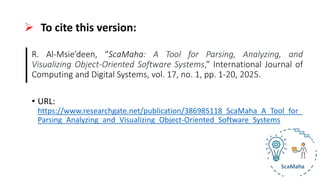

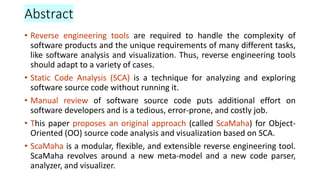










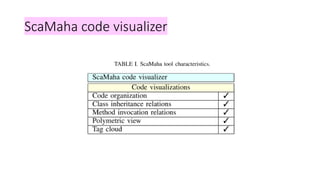

![Related Work
• ScaMaha* is a reverse engineering tool for parsing, analyzing, and visualizing
software source code.
• Moose is a well-known reverse engineering tool [1]. It began as a research
project around 24 years ago.
• MODMOOSE is the new version of Moose [2]. Tool developers can develop
specialized reverse engineering tools with MODMOOSE. Moose was based on the
Famix metamodel [3].
[ScaMaha] https://github.com/rafat66/ScaMaha
[1] O. Nierstrasz, S. Ducasse, and T. Gˆırba, “The story of moose: an agile reengineering environment,” in Proceedings of the
10th European Software Engineering Conference held jointly with 13th ACM SIGSOFT International Symposium on
Foundations of Software Engineering, 2005, Lisbon, Portugal, September 5-9, 2005, M. Wermelinger and H. C. Gall, Eds. ACM,
2005, pp. 1–10. [Online]. Available: https://doi.org/10.1145/1081706.1081707
[2] N. Anquetil, A. Etien, M. H. Houekpetodji, B. Verhaeghe, S. Ducasse, C. Toullec, F. Djareddir, J. Sudich, and M. Derras,
“Modular moose: A new generation of software reverse engineering platform,” in Reuse in Emerging Software Engineering
Practices, S. Ben Sassi, S. Ducasse, and H. Mili, Eds. Cham: Springer International Publishing, 2020, pp. 119–134.
https://link.springer.com/chapter/10.1007/978-3-030-64694-3_8
[3] S. Ducasse, N. Anquetil, M. U. Bhatti, A. C. Hora, J. Laval, and T. Gˆırba, “MSE and FAMIX 3.0: an interexchange format and
source code model family,” 2011, [Online]. Available: https://inria.hal.science/hal-00646884/document (Accessed: Feb. 5,
2024).](https://image.slidesharecdn.com/scamaha-atoolforparsinganalyzingandvisualizingobject-orientedsoftwaresystems-presentation-250115193807-1325ac6b/85/ScaMaha-A-Tool-for-Parsing-Analyzing-and-Visualizing-Object-Oriented-Software-Systems-17-320.jpg)
![Related Work ... [continued]
• Bruneliere et al. [4] suggested a semantic and syntax analysis-based
parser for the creation of AST and metrics for multi-language
software systems. Their meta-modeling tool [5] is utilized to analyze
multi-language applications [6].
[4] H. Bruneliere, J. Cabot, F. Jouault, and F. Madiot, “Modisco: a generic and extensible framework for model driven reverse
engineering,” in ASE 2010, 25th IEEE / ACM International Conference on Automated Software Engineering, Antwerp, Belgium,
September 20-24, 2010, C. Pecheur, J. Andrews, and E. D. Nitto, Eds. ACM, 2010, pp. 173–174. [Online]. Available:
https://doi.org/10.1145/1858996.1859032
[5] H. Bruneliere. (2010) MoDisco. [Online]. Available: https://www.eclipse.org/MoDisco/ (Accessed: Feb. 5, 2024).
[6] H. Bruneliere, J. Cabot, G. Dup´e, and F. Madiot, “Modisco: A model driven reverse engineering framework,” Inf. Softw. Technol.,
vol. 56, no. 8, pp. 1012–1032, 2014. [Online]. Available: https://doi.org/10.1016/j.infsof.2014.04.007](https://image.slidesharecdn.com/scamaha-atoolforparsinganalyzingandvisualizingobject-orientedsoftwaresystems-presentation-250115193807-1325ac6b/85/ScaMaha-A-Tool-for-Parsing-Analyzing-and-Visualizing-Object-Oriented-Software-Systems-18-320.jpg)
![Related Work ... [continued]
• VerveineJ is a parser developed in Java that constructs an MSE file from
software source code [7].
• Wettel and Lanza [8] have suggested an automatic tool called CodeCity.
This tool visualizes software source code as a city metaphor. CodeCity is an
interactive, three-dimensional software visualization tool [9].
[7] Moose VerveineJ. (2023) VerveineJ. [Online]. Available: https://modularmoose.org/moose-
wiki/Developers/Parsers/VerveineJ.html (Accessed: Feb. 5, 2024).
[8] R. Wettel and M. Lanza, “Visualizing software systems as cities,” in Proceedings of the 4th IEEE International Workshop on
Visualizing Software for Understanding and Analysis, VISSOFT 2007. IEEE Computer Society, 2007, pp. 92–99. [Online].
Available: https://doi.org/10.1109/VISSOF.2007.4290706
[9] D. Moreno-Lumbreras, R. Minelli, A. Villaverde, J. M. Gonz´alez-Barahona, and M. Lanza, “Codecity: A comparison of on-
screen and virtual reality,” Inf. Softw. Technol., vol. 153, p. 107064, 2023. [Online]. Available:
https://doi.org/10.1016/j.infsof.2022.107064](https://image.slidesharecdn.com/scamaha-atoolforparsinganalyzingandvisualizingobject-orientedsoftwaresystems-presentation-250115193807-1325ac6b/85/ScaMaha-A-Tool-for-Parsing-Analyzing-and-Visualizing-Object-Oriented-Software-Systems-19-320.jpg)
![Related Work ... [continued]
• The Java language has a wide variety of parsers due to its long history of
development, popularity, and huge number of applications nowadays.
• Numerous tools exist that turn software code into a tree-like structure,
such as interpreters and compilers.
• There are several Java parsers for various contexts because there are so
many different Java applications, such as Spoon [10], SrcML [11], and
SuperParser [12].
[10] R. Pawlak, M. Monperrus, N. Petitprez, C. Noguera, and L. Seinturier, “SPOON: A library for implementing analyses and
transformations of java source code,” Softw. Pract. Exp., vol. 46, no. 9, pp. 1155–1179, 2016. [Online]. Available:
https://doi.org/10.1002/spe.2346
[11] M. L. Collard, M. J. Decker, and J. I. Maletic, “SrcML: An infrastructure for the exploration, analysis, and manipulation of
source code: A tool demonstration,” in 2013 IEEE International Conference on Software Maintenance, Eindhoven, The
Netherlands, September 22-28, 2013. IEEE Computer Society, 2013, pp. 516–519. [Online]. Available:
https://doi.org/10.1109/ICSM.2013.85
[12] I. Utkin, E. Spirin, E. Bogomolov, and T. Bryksin, “Evaluating the impact of source code parsers on ML4SE models,” CoRR,
vol. abs / 2206.08713, 2022. [Online]. Available: https://doi.org/10.48550/arXiv.2206.08713](https://image.slidesharecdn.com/scamaha-atoolforparsinganalyzingandvisualizingobject-orientedsoftwaresystems-presentation-250115193807-1325ac6b/85/ScaMaha-A-Tool-for-Parsing-Analyzing-and-Visualizing-Object-Oriented-Software-Systems-20-320.jpg)
![Related Work ... [continued]
• The methods of software source code visualization have become increasingly
utilized to support software engineers in software understanding. In software
visualization, some methods aim at displaying software source code in a
recognized environment, like a forest [13] or a city.
• Another method is to generate what is called a polymetric view [14], described as
a lightweight visualization technique supplemented with several metrics
regarding software code.
• ScaMaha visualizes different aspects of software source code, such as code
organization and relations.
[13] U. Erra and G. Scanniello, “Towards the visualization of software systems as 3D forests: the codeTrees environment,” in
Proceedings of the ACM Symposium on Applied Computing, SAC 2012, Riva, Trento, Italy, March 26-30, 2012, S. Ossowski and
P. Lecca, Eds. ACM, 2012, pp. 981–988. [Online]. Available: https://doi.org/10.1145/2245276.2245467
[14] M. Lanza and S. Ducasse, “Polymetric views - A lightweight visual approach to reverse engineering,” IEEE Trans. Software
Eng., vol. 29, no. 9, pp. 782–795, 2003. [Online]. Available: https://doi.org/10.1109/TSE.2003.1232284](https://image.slidesharecdn.com/scamaha-atoolforparsinganalyzingandvisualizingobject-orientedsoftwaresystems-presentation-250115193807-1325ac6b/85/ScaMaha-A-Tool-for-Parsing-Analyzing-and-Visualizing-Object-Oriented-Software-Systems-21-320.jpg)
![Related Work ... [continued]
• Lyons et al. [15] have suggested the lightweight multilingual software analysis
method to analyze software systems. They use several code parsers, one for
every programming language. The main goal of this work is to create a software
engineering tool that addresses large and complex software systems in a
lightweight and extensible style.
• The current version of the ScaMaha tool uses only one code parser for the Java
language.
[15] D. M. Lyons, A. M. Bogar, and D. Baird, “Lightweight multilingual software analysis,” in Proceedings of the 12th
International Conference on Software Technologies, ICSOFT 2017, Madrid, Spain, July 24-26, 2017, J. Cardoso, L. A.
Maciaszek, M. van Sinderen, and E. Cabello, Eds. SciTePress, 2017, pp. 201–207. [Online]. Available:
https://doi.org/10.5220/0006392502010207](https://image.slidesharecdn.com/scamaha-atoolforparsinganalyzingandvisualizingobject-orientedsoftwaresystems-presentation-250115193807-1325ac6b/85/ScaMaha-A-Tool-for-Parsing-Analyzing-and-Visualizing-Object-Oriented-Software-Systems-22-320.jpg)









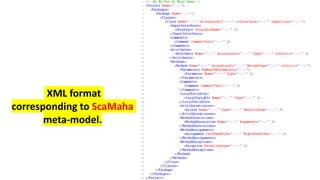
![The code file of
mobile photo
software as an XML
file (partial) [16].](https://image.slidesharecdn.com/scamaha-atoolforparsinganalyzingandvisualizingobject-orientedsoftwaresystems-presentation-250115193807-1325ac6b/85/ScaMaha-A-Tool-for-Parsing-Analyzing-and-Visualizing-Object-Oriented-Software-Systems-33-320.jpg)





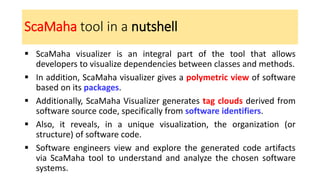

![<< Component >>
ScaMaha Parser
[Static Code Analysis]
<< Java Source Code >>
[Software Product]
<< Code File >>
[ScaMaha Meta-model,
XML File]
uses
produces
<< Component >>
ScaMaha Analyzer
uses
<< Software Metrics File >>
[XML File - Metadata]
<< Component >>
ScaMaha
<< Component >>
JDOM Library
uses
<< Component >>
ScaMaha Visualizer
uses
<< Component >>
Graphviz Library
produces
uses
uses
<< DOT File >>
[Graph Description Language]
produces
uses
<< Graph Visualization >>
[SVG, PNG, PDF, or GIF File]
produces
Software
source code
Metrics File
Code Graphs
Source Code
Code File
Dot File
<< Code File >>
[ScaMaha Meta-model,
XML File]
Code file,
metrics file, and
code graphs
uses produces](https://image.slidesharecdn.com/scamaha-atoolforparsinganalyzingandvisualizingobject-orientedsoftwaresystems-presentation-250115193807-1325ac6b/85/ScaMaha-A-Tool-for-Parsing-Analyzing-and-Visualizing-Object-Oriented-Software-Systems-41-320.jpg)










![The code file of drawing shapes
software as an XML file (partial) [16].](https://image.slidesharecdn.com/scamaha-atoolforparsinganalyzingandvisualizingobject-orientedsoftwaresystems-presentation-250115193807-1325ac6b/85/ScaMaha-A-Tool-for-Parsing-Analyzing-and-Visualizing-Object-Oriented-Software-Systems-52-320.jpg)


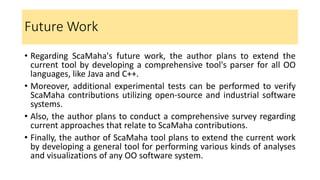
![References
[16] R. A. A. Al-Msie’deen. (2023) ScaMaha. [Online]. Available:
https://drive.google.com/drive/folders/11_CItJ2pPq_1CAWswcjRsAZnhmQO6OQ8
(Accessed: Feb. 5, 2024).](https://image.slidesharecdn.com/scamaha-atoolforparsinganalyzingandvisualizingobject-orientedsoftwaresystems-presentation-250115193807-1325ac6b/85/ScaMaha-A-Tool-for-Parsing-Analyzing-and-Visualizing-Object-Oriented-Software-Systems-56-320.jpg)

